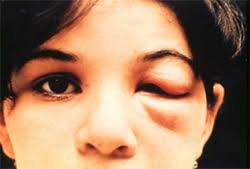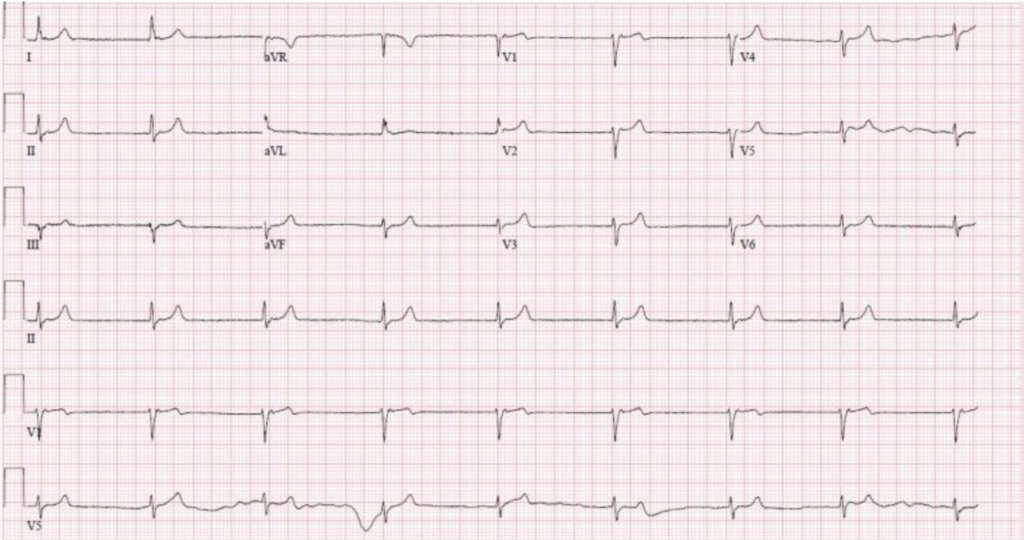History
A 15-year-old female from rural Brazil visits the clinic with a history of swelling around her eye, fatigue, and intermittent fever. These symptoms began a few weeks after she noticed a bug bite on her face while sleeping. She also reports occasional palpitations and mild chest discomfort.

Examination
On physical examination, the patient presents with the following findings:
- Vital Signs: Mild fever, heart rate slightly elevated.
- Head and Neck: Romana’s sign (unilateral painless periorbital swelling) around the right eye.
- Cardiovascular: Mild tachycardia, with no murmurs detected.
- Abdominal: No hepatosplenomegaly or tenderness.
- Neurological: Normal, with no focal deficits.
Diagnosis
Initial Assessment
The patient’s history of a bug bite and her presenting symptoms, including fever, Romana’s sign, and palpitations, raised the initial suspicion of Chagas disease. To confirm the diagnosis, we proceeded with a series of laboratory and diagnostic tests.
Laboratory Tests
- Blood Smear: A blood smear was prepared and examined under a microscope. This test revealed the presence of Trypanosoma cruzi parasites in her blood, confirming the acute phase of Chagas disease.
- Serological Tests: We conducted an enzyme-linked immunosorbent assay (ELISA) to detect antibodies against T. cruzi. The test returned positive for both IgM and IgG antibodies, indicating a current infection and a possible chronic phase.
- Polymerase Chain Reaction (PCR): To further confirm the diagnosis, a PCR test was performed. This test detected T. cruzi DNA in her blood, offering high sensitivity and specificity, especially useful in early infection.
Cardiac Evaluation
- Electrocardiogram (ECG): Given her complaints of palpitations and chest discomfort, an ECG was performed. The results showed mild conduction abnormalities, including right bundle branch block, indicative of cardiac involvement typical in Chagas disease.
- Echocardiogram: An echocardiogram was done to assess heart function and structure. It revealed mild left ventricular dilation, an early sign of Chagas cardiomyopathy.
Gastrointestinal Evaluation
- Imaging Tests: Though the patient did not present with gastrointestinal symptoms, X-rays and barium studies were conducted as part of a thorough evaluation. These tests did not reveal any abnormalities, ruling out megaesophagus and megacolon at this stage.
The combination of clinical findings, positive laboratory tests, and cardiac evaluation confirmed the diagnosis of Chagas disease. The patient was diagnosed with acute Chagas disease with early cardiac involvement.
What is Chagas Disease?
Chagas disease, also known as American trypanosomiasis, is a parasitic disease caused by Trypanosoma cruzi. It is endemic to Latin America and is primarily transmitted through the feces of triatomine bugs, also known as “kissing bugs.”
Cause
Chagas disease is caused by the protozoan parasite Trypanosoma cruzi. The primary mode of transmission is through the bite of infected triatomine bugs. Other transmission routes include:
- Congenital Transmission: From mother to child during pregnancy.
- Blood Transfusion: Receiving contaminated blood.
- Organ Transplantation: From infected donors.
- Food Contamination: Consuming food contaminated with T. cruzi.
Signs and Symptoms
Acute Phase
- Fever: Persistent fever is a common initial symptom.
- Romana’s Sign: Swelling around the eye at the site of the insect bite.
- Fatigue and Malaise: General feeling of discomfort and lack of energy.
- Body Aches: Muscle pain and headaches.
- Rash and Diarrhea: Occasional skin eruptions and gastrointestinal upset.
Chronic Phase
- Cardiac Complications: Heart failure, arrhythmias, and cardiomyopathy.
- Gastrointestinal Problems: Megaesophagus and megacolon, leading to difficulty swallowing and severe constipation.
- Neurological Symptoms: Stroke, peripheral neuropathy, and dementia.
Diagnosis
Clinical Assessment
- Patient History: Involves assessing travel history, exposure to triatomine bugs, and initial symptoms.
- Physical Examination: Checking for signs such as Romana’s sign and general symptoms of infection.
Laboratory Tests
- Blood Smear: Direct observation of T. cruzi in blood samples.
- Serological Tests: Detection of antibodies against T. cruzi, confirming chronic infection.
- Polymerase Chain Reaction (PCR): Highly sensitive detection of T. cruzi DNA.
Cardiac and Gastrointestinal Evaluation
- Electrocardiogram (ECG): To identify any heart rhythm abnormalities.
- Echocardiogram: For assessing heart function and structure.
- Imaging Tests: X-rays and barium studies to detect gastrointestinal complications like megacolon or megaesophagus.
Treatment
Acute Phase
- Antiparasitic Medications: Benznidazole and nifurtimox are effective in reducing the parasite load and preventing progression to chronic disease. Early treatment is crucial.
Chronic Phase
- Symptomatic Treatment:
- Cardiac Complications: Use of heart failure medications, antiarrhythmics, and pacemakers.
- Gastrointestinal Issues: Surgical interventions and medications to manage symptoms.
- Ongoing Monitoring: Regular follow-ups with a healthcare provider to monitor disease progression and manage complications.
Complications
Cardiac Complications
- Heart Failure: Due to damage to the heart muscle.
- Arrhythmias: Irregular heartbeats that can lead to sudden death.
- Thromboembolism: Increased risk of blood clots due to heart damage.
Gastrointestinal Complications
- Megaesophagus: Difficulty swallowing and malnutrition.
- Megacolon: Severe constipation and abdominal pain.
Neurological Complications
- Stroke: Due to cardiac embolism or direct invasion of the nervous system.
- Peripheral Neuropathy: Nerve damage leading to pain, numbness, and weakness.
- Cognitive Decline: In severe cases, dementia may develop.
Conclusion
Chagas disease poses a significant health threat in endemic regions. Early detection and treatment are vital to prevent chronic complications.
Read more:
